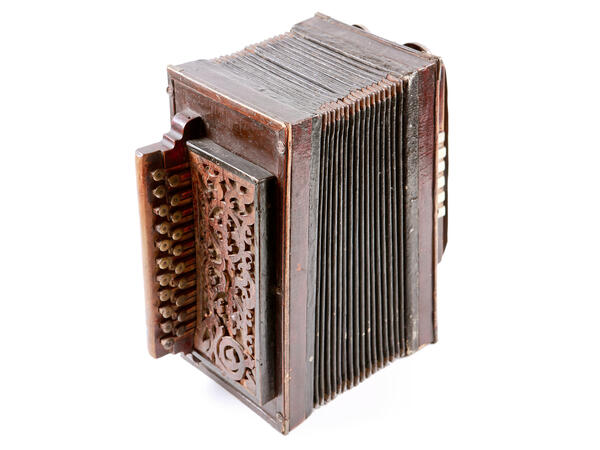The museum collection contains a “kasimovka”— a two-row accordion, which was invented by the craftsmen from Kasimov District of the Ryazan Governorate in the 19th century. It differed from other varieties of accordions in its structure and sound range.
A “kasimovka” had two rows of buttons: 21 or 19 buttons in each row, and models made in other towns had only one row of buttons. As a result, the accordion had an extended range of sounds. On the left side of the keyboard, there were only basses, without full chords. The sequence of the ‘Russian tuning’ on the right side was the same as that of other accordions.
Accordionists who were used to playing on “kasimovkas” considered other accordions unsuitable. Therefore, musicians from Murom, Ryazan, Kolomna, and other towns often ordered instruments from Kasimov craftsmen.
It is not known for certain where the first accordions appeared. According to one version, this musical instrument was invented in Germany. According to another version, it was created by the Czech master František Kiršnik in St. Petersburg in the Russian Empire.
However, immediately after the invention, the accordion became popular in Russia. In the 1830s, it could be found in all major cities of the country; merchants, artists, sailors brought a musical instrument from abroad. Soon Russian craftsmen began to copy it, and then improve it — this is how the accordion of the ‘Russian tuning’ appeared. In it, the keys with reeds are turned over with the other side to the valves, so when the bellows were expanded and compressed, different sounds than those of foreign instruments were obtained.
One of the centers of accordion production in Russia was the city of Tula. The sound capabilities of the classic ‘Tula’ musical instrument were limited: it had only one row of keys that corresponded to the sounds. Then, the Russian craftsmen developed the design of a two-row accordion, and the number of sounds and semitones that the instrument produced increased.
In addition to Kasimov, two-row accordions were produced in several other places, for example, in the Bologoye village, the St. Petersburg Governorate. The first row of the right keyboard of the instrument repeated the scheme of the Tula accordion, and the second contained a sound scale a quart higher. Moreover, some of the sounds of the first row, extracted when compressing the bellow, were duplicated in the second row when expanding.
A “kasimovka” had two rows of buttons: 21 or 19 buttons in each row, and models made in other towns had only one row of buttons. As a result, the accordion had an extended range of sounds. On the left side of the keyboard, there were only basses, without full chords. The sequence of the ‘Russian tuning’ on the right side was the same as that of other accordions.
Accordionists who were used to playing on “kasimovkas” considered other accordions unsuitable. Therefore, musicians from Murom, Ryazan, Kolomna, and other towns often ordered instruments from Kasimov craftsmen.
It is not known for certain where the first accordions appeared. According to one version, this musical instrument was invented in Germany. According to another version, it was created by the Czech master František Kiršnik in St. Petersburg in the Russian Empire.
However, immediately after the invention, the accordion became popular in Russia. In the 1830s, it could be found in all major cities of the country; merchants, artists, sailors brought a musical instrument from abroad. Soon Russian craftsmen began to copy it, and then improve it — this is how the accordion of the ‘Russian tuning’ appeared. In it, the keys with reeds are turned over with the other side to the valves, so when the bellows were expanded and compressed, different sounds than those of foreign instruments were obtained.
One of the centers of accordion production in Russia was the city of Tula. The sound capabilities of the classic ‘Tula’ musical instrument were limited: it had only one row of keys that corresponded to the sounds. Then, the Russian craftsmen developed the design of a two-row accordion, and the number of sounds and semitones that the instrument produced increased.
In addition to Kasimov, two-row accordions were produced in several other places, for example, in the Bologoye village, the St. Petersburg Governorate. The first row of the right keyboard of the instrument repeated the scheme of the Tula accordion, and the second contained a sound scale a quart higher. Moreover, some of the sounds of the first row, extracted when compressing the bellow, were duplicated in the second row when expanding.


